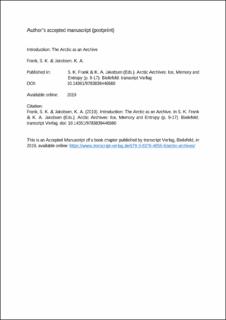| dc.contributor.author | Frank, Susi K. | |
| dc.contributor.author | Jakobsen, Kjetil Ansgar | |
| dc.coverage.spatial | The Arctic | en_US |
| dc.date.accessioned | 2020-06-29T12:02:54Z | |
| dc.date.available | 2020-06-29T12:02:54Z | |
| dc.date.created | 2019-09-12T17:04:47Z | |
| dc.date.issued | 2019 | |
| dc.identifier.citation | Frank, S. K. & Jakobsen, K. A. (2019). Introduction: The Arctic as an Archive. In S. K. Frank & K. A. Jakobsen (Eds.), Arctic Archives: Ice, Memory and Entropy (p. 9-17). Bielefeld: transcript Verlag. doi: | en_US |
| dc.identifier.isbn | 978-3837646566 | |
| dc.identifier.uri | https://hdl.handle.net/11250/2659888 | |
| dc.description | Author's accepted version (postprint).
This is an Accepted Manuscript of a book chapter published by transcript Verlag, Bielefeld, in
2019.
Available online: https://www.transcript-verlag.de/978-3-8376-4656-6/arctic-archives/ | en_US |
| dc.description | This is an Accepted Manuscript of a book chapter published by transcript Verlag, Bielefeld, in 2019. | |
| dc.description | Available online: https://www.transcript-verlag.de/978-3-8376-4656-6/arctic-archives/ | |
| dc.description.abstract | This introductory articles explains the key concepts and issues for the volume. The Arctic is an important and highly endangered archive of knowledge about natural as well as human history of the Anthropocene. Focusing on the Arctic as an archive means not only to investigate it as a place of human history and memory―of Arctic exploring, conquering, and colonizing―but to take into account also the specific environmental conditions of the circumpolar region: ice and permafrost. These have allowed a huge natural archive to emerge, offering rich sources for natural scientists and historians alike. Notably the articles reviews the debate on the notion of (“natural”) archive, the concept of entropoy and the cultural semantics and historicity of the meaning of concepts like “warm,” “cold,” “freezing,” and “melting. What kind of memory supports do. Media in nature and culture, like snow and ice, earth and stone, but also film, photography and text can all be seen as memory supports. How do they differ in what they remember and what they forget? What kind of events are preserved in ice, for example compared to earth, and what is discarded, and what information is provided when entropy rises? | en_US |
| dc.language.iso | eng | en_US |
| dc.publisher | transcript Verlag | en_US |
| dc.relation.ispartof | Arctic Archives: Ice, Memory and Entropy | |
| dc.relation.ispartofseries | Culture & Theory;Vol. 194 | |
| dc.subject | Arkivteori, arktis, antropocen | en_US |
| dc.subject | Archive theory, Arctis, anthropocene | en_US |
| dc.title | Introduction : The Arctic as an Archive | en_US |
| dc.type | Chapter | en_US |
| dc.description.version | acceptedVersion | en_US |
| dc.subject.nsi | VDP::Humaniora: 000 | en_US |
| dc.subject.nsi | VDP::Humanities: 000 | en_US |
| dc.subject.nsi | VDP::Humaniora: 000::Historie: 070 | en_US |
| dc.subject.nsi | VDP::Matematikk og Naturvitenskap: 400::Geofag: 450 | en_US |
| dc.identifier.doi | 10.14361/9783839446560-fm | |
| dc.identifier.cristin | 1724149 | |
| dc.relation.project | Internasjonale institusjoner: Fritz Thyssen Foundation | en_US |
